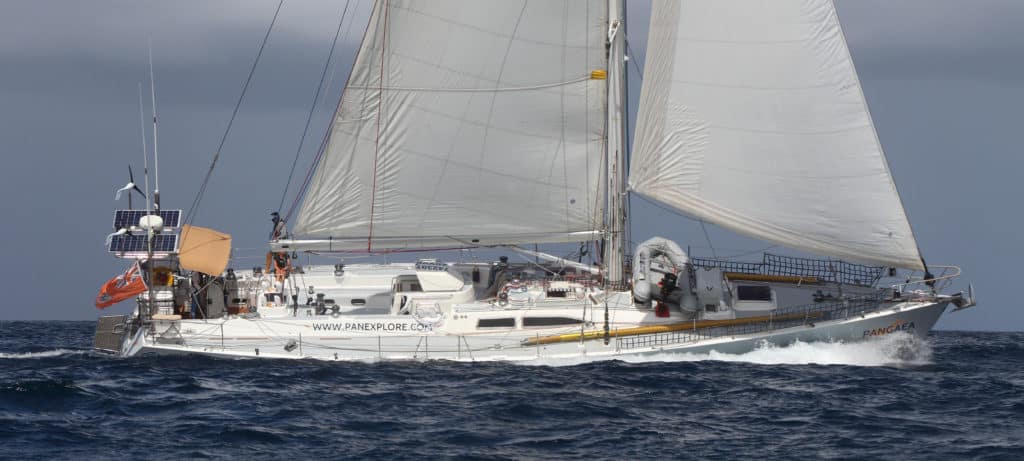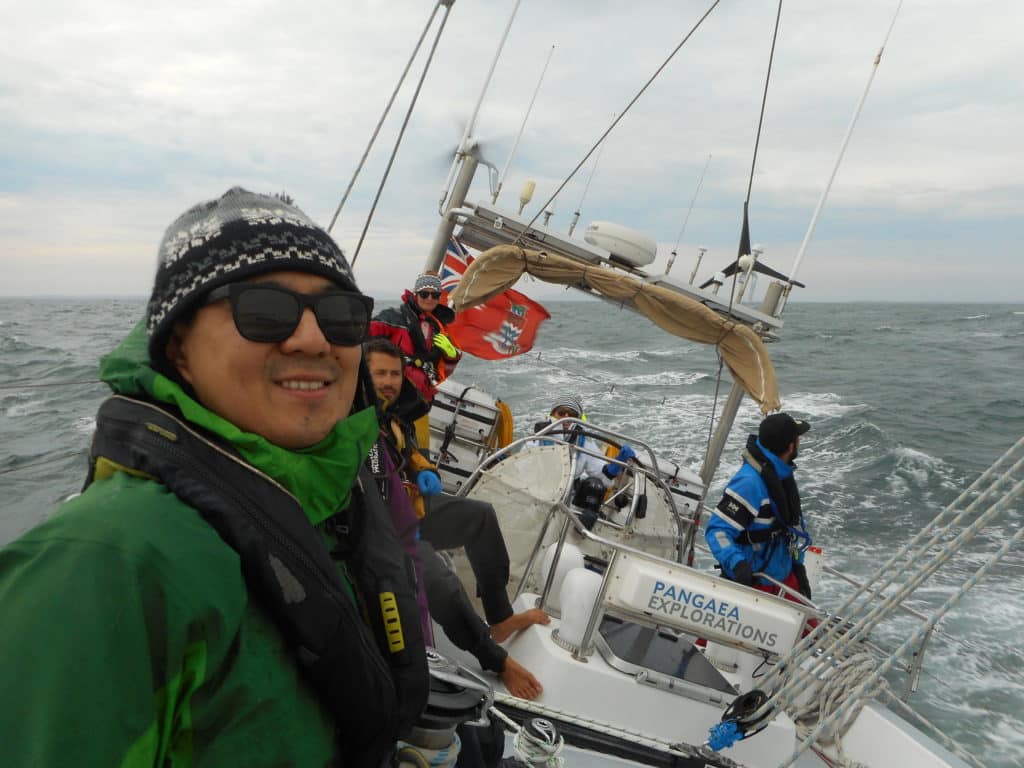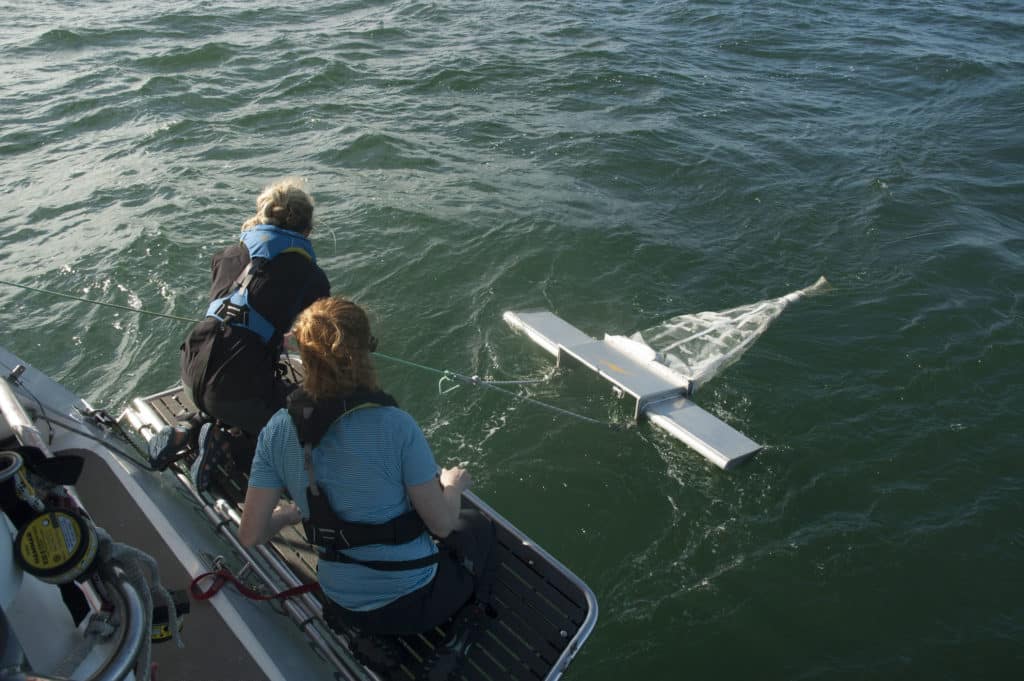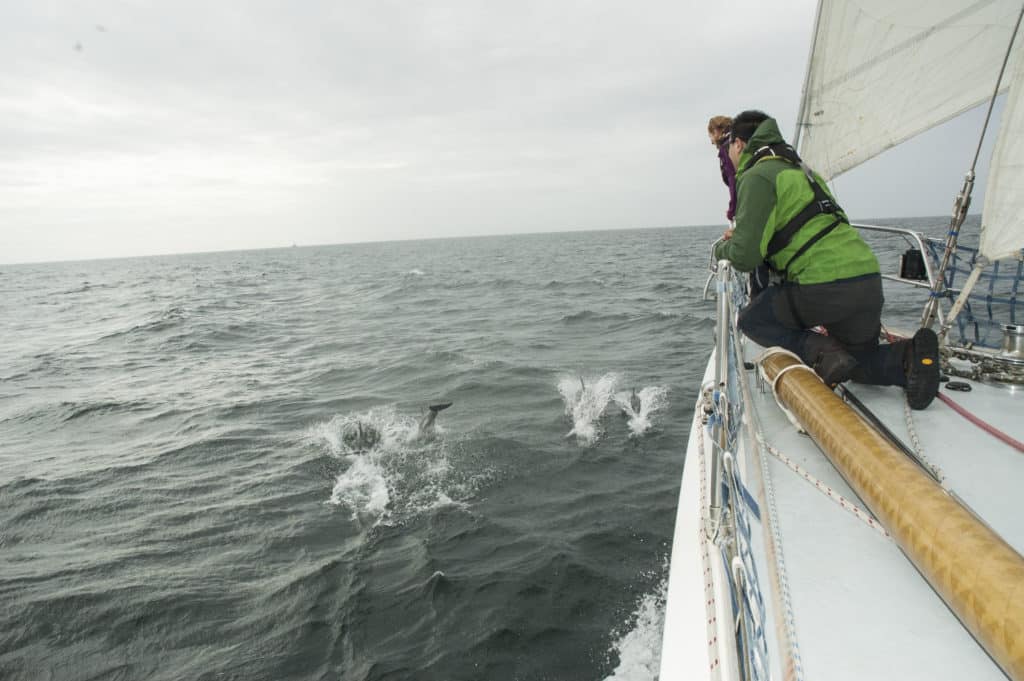
The line of wind at the edge of the harbor as we dodged lobster pots on our way out of Camden, Maine, looked like it had been painted on the water with black ink. Immediately, we were in 20 to 30 knots on the nose.
Sea Dragon, my ride for the just-beginning roughly 735-nautical-mile passage to Bermuda, was made for these conditions, and worse. The 72-foot steel expedition yacht had been built for the around-the-world Global Challenge race, and is now run by the adventure charter outfit Pangaea Exploration. “She really boogies upwind in 25 to 30 knots,” skipper Eric Loss told me. I didn’t doubt it. When I first saw Sea Dragon on the dock, I thought, What a beast. This boat can handle some abuse. The extensive safety briefings before we set out only deepened the impression.
We were a crew of seven, which made Sea Dragon, which has berths for 16, feel quite roomy. And we were in good hands. Our captain did a solo circumnavigation after college and had been sailing Sea Dragon for the past four years. First mate and medic Shanley McEntee also had extensive offshore experience, including skippering Sea Dragon for Pangaea’s annual all-female expeditions. Deckhand Tom McMahon was aboard Sea Dragon while on “vacation” from his normal job — teaching people to sail as an International Yacht and Maritime Training instructor in Croatia. The rest of us were active passengers: along for the ride and hoping to pick up some skills between Maine and Bermuda while standing watches and participating in all shipboard activities. Pei Huang, a college mate with the captain at Bowdoin, had once joined him for a charter vacation in the Caribbean. Pei’s wife, Lauren Keenan, grew up around boats and sailed in college. This was the third expedition aboard Sea Dragon for retired English professor Steve Lansky, and he was hoping to gain some sea stories to weave into a climate-change-based science-fiction novel he was writing in which the lead characters sail to Cuba. And then there was me, a lifelong sailor who had recently spent more time tickling a keyboard than tying bowlines. I was excited to get back out to sea.

We raised the main with a double reef, and then the yankee jib. As soon as the sails were trimmed I could see what Eric had meant by “boogie.” At the helm, I could feel the power as we punched through the considerable swell. But for all the fun of going fast — 10 to 12 knots, most of the time — it was not a comfortable ride. The mid-October wind was cold, and Penobscot Bay was bumpy. The forecast was for it to stay that way for a couple of days, followed by some light air, followed by a tropical something that we hoped wouldn’t actually materialize. I had started taking Stugeron the day before, just in case.
Pei was the first victim of the disorganized motion, followed shortly by Lauren. A bit later Eric came up the companionway and announced, “I’m feeling a bit pukey,” in the same chipper voice he might have used to say, “Today is my birthday!” He then turned to the leeward rail, threw up and added, “Well, that’s better,” before hosing down the side deck and ducking back below. He later told me it was the first time he’d been seasick in his four years aboard Sea Dragon. We were all miserable.
Shanley heated tomato soup and handed up mugs for dinner so no one would have to eat below. It was a good move because we were blasting and banging along at a pretty good clip. If we kept it up, we would cover half the distance to Bermuda in just two days. Could we handle two whole days of this? I mentally calculated how long I could stay on deck before I’d need to go below to use the head. If I threw up, was it possible I could go longer without having to pee?
Just as darkness fell, we lunged off a wave and Steve was thrown from his seat on the windward side of the cockpit and landed hard on the leeward settee. “Tacking!” Shanley yelled and immediately hove to.
What happened next were the steps you always hear about in sail-training courses. Shanley handed me the wheel and did an initial check with Steve to assess the severity of his condition. Eric came up and helped get Steve below so they could get him out of his layers to check out his ribs and back, which were causing him pain. Tom came on deck to keep me company. Shanley got on the satphone with the on-call doctor from Medical Support Offshore Limited, a shoreside service that Pangaea Exploration subscribes to. Together with the doctor on the phone and input from Steve, the decision was made to turn back to Camden. We’d only been sailing half the day and would be back at the dock around midnight.
Noone ever wants to turn back to port, but Eric, Shanley and Tom made the prudent choice. When we left Camden, seven had seemed like a good number of crew, but with so many of us seasick, some to the point of incapacitation, I was struck by how quickly we felt shorthanded. And given the uncertainty of Steve’s condition — was it possible he had broken a rib? — there was really no discussion needed.

I’ll admit I was relieved to hear the news. Despite my watch ending a few hours before, I had been avoiding going below to sleep because I didn’t think I’d be able to hold down my few bites of dinner. I was worried about Steve, but more so daunted by the conditions.
And then we were flying along with the wind and waves on our port quarter, heading back to Camden. The four hours it took — half the time we’d spent banging uphill — were the kind of sailing I daydream about. It felt like a different ocean, a different planet from what we’d been in all afternoon. The full supermoon occasionally peeked through the clouds and lit up the sky and sparkled off the water. By the time we were back in the bay, the clouds had cleared enough that we didn’t need to use lights to dodge lobster pots.
Ashore, Eric and Shanley took Steve to the hospital to get checked out. Knowing that my family would be watching the boat’s tracker online, I went up to the marina’s customer lounge to send them an update. I already had an email waiting for me. “Looks like you’re making good time, back to Maine,” my dad wrote. My mom had called my husband, Nate, to alert him we’d stopped and then turned back. Nate looked at the track and conjectured that it must not be a major emergency since we hadn’t pulled into Matinicus Island, the closest land to our turnaround spot. I shot off a quick note that we were safe, and then passed out in my bunk.
I awoke to find everyone back at the boat. Steve was bruised and sore, but luckily nothing was broken. We talked over our options and decided to do a coastal cruise to Rhode Island. Our weather window to Bermuda had closed, with a dubious-looking depression forming in our path. We spent the day regrouping, hiking and exploring Camden. When we met back up for dinner everyone was feeling human again and excited for our tour of New England — even Steve, who was clearly hurting but putting on one hell of a brave face. The general plan was to sail south, stopping for the night in Portland, Maine; Gloucester and Woods Hole, Massachusetts; and then either Newport or Block Island, Rhode Island.
We were happy to find the wind on our beam at about 16 knots when we made our way back out of Camden on Tuesday morning. Weaving, once again, through lobster pots, we passed a slew of small, pine-covered islands that we all agreed “looked very Maine.” Midday, the fog rolled in thick and we agreed that the weather was also “very Maine.” We caught a pot under sail, and Eric had to dive in to free us; after that, we kept three people on pot watch at all times. It was peaceful being up at the bow, peering into the soupy air.

I went below to make dinner as we neared Cliff Island, near Portland, our anchorage for the night. I was grateful for the warmth of the galley after getting soaked by the fog. It was cozy eating around Sea Dragon‘s saloon table and talking sailing.
We had brilliant sailing in 15 to 20 knots on Wednesday under yankee jib, staysail and main with a single reef. The seas were moderate: better than they had been on our first day out, but I still didn’t want to hang out below too long. For the first time all week, we had bright sun, and the boost in morale was noticeable.
It was hot as we struck the sails at the mouth of the harbor in Gloucester. Everyone stripped down out of their layers to T-shirts and tank tops. Shanley had arranged for us to tie alongside a barge at the marine railway, and we had beautiful light as we squared everything away.
A previous mate from Sea Dragon, Andy Rogan, now works for a whale-research group called Ocean Alliance (whale.org), and we walked over to see its offices in the old Gloucester paint factory. They’re doing some really cool things with SnotBots, drones with petri dishes that fly over spouting whales. It was incredible to hear how they could collect DNA from the whales without ever touching them.
We found a restaurant that was having a half-price offseason special, and were amazed at how strong beer seemed after the dehydrating effects of a long day in the sun. On our way back to the boat, we got a bit of a jolt when we realized just how far the tide had gone out. The route down to the barge entailed a rickety, rusted ladder of questionable integrity. I can only imagine what was going through Steve’s mind, sore as he was. Luckily, we all made it down without mishaps.
– – –
Eleanor Merrill is Cruising World’s Managing Editor. Click here for Part 2 of this story.








